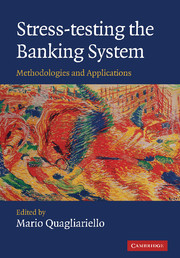Book contents
- Frontmatter
- Contents
- List of figures
- List of tables
- List of boxes
- List of contributors
- Foreword
- Acknowledgements
- Introduction
- Part I Fundamentals
- 1 A framework for assessing financial stability
- 2 Macroeconomic stress-testing: definitions and main components
- 3 Macroeconomic stress-testing banks: a survey of methodologies
- 4 Scenario design and calibration
- 5 Risk aggregation and economic capital
- 6 Data needs for stress-testing
- 7 Use of macro stress tests in policy-making
- Part II Applications
- Conclusions
- Index
- References
2 - Macroeconomic stress-testing: definitions and main components
from Part I - Fundamentals
Published online by Cambridge University Press: 18 December 2009
- Frontmatter
- Contents
- List of figures
- List of tables
- List of boxes
- List of contributors
- Foreword
- Acknowledgements
- Introduction
- Part I Fundamentals
- 1 A framework for assessing financial stability
- 2 Macroeconomic stress-testing: definitions and main components
- 3 Macroeconomic stress-testing banks: a survey of methodologies
- 4 Scenario design and calibration
- 5 Risk aggregation and economic capital
- 6 Data needs for stress-testing
- 7 Use of macro stress tests in policy-making
- Part II Applications
- Conclusions
- Index
- References
Summary
Introduction
As described in Chapter 1, the financial sector is particularly prone to fragility, contagion and, thus, systemic crises. In general, the episodes of instability are the consequence of the existing weaknesses, while the external shock simply ignites the crisis: the more fragile the financial system, the more severe the effects of a crisis.
Therefore, it is important to evaluate the linkages between the conditions of the macroeconomy and the stability of the financial system. The first step in such assessment is the evaluation of the current state of health of the financial system. This is typically done using both aggregated microdata and macroeconomic indicators, called financial soundness (or macroprudential) indicators by practitioners. The second step is the assessment of the resilience of the system, i.e., its ability to absorb potential exogenous shocks. This analysis is typically carried out through stress tests. Since credit institutions are the backbone of the financial system in most countries, the scrutiny focuses very often on the banking sector.
This chapter provides a general overview of stress-testing, introducing the main concepts and describing the most relevant components. In Chapter 3, the quantitative methodologies for stress-testing the main banking risks are analysed.
Objectives of stress-testing: the micro and macro perspectives
Stress-testing techniques have been applied at the individual level by large, internationally active banks since the early 1990s. They are generally used in the context of banks' risk management in order to complement the estimates derived by internal models.
- Type
- Chapter
- Information
- Stress-testing the Banking SystemMethodologies and Applications, pp. 18 - 36Publisher: Cambridge University PressPrint publication year: 2009
References
- 5
- Cited by



